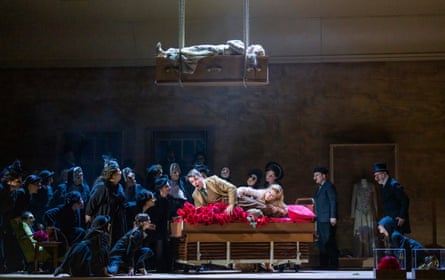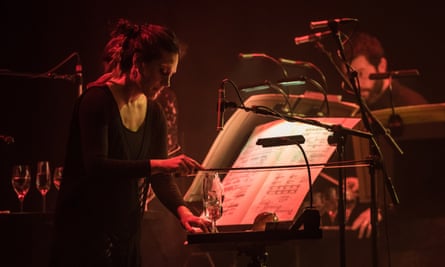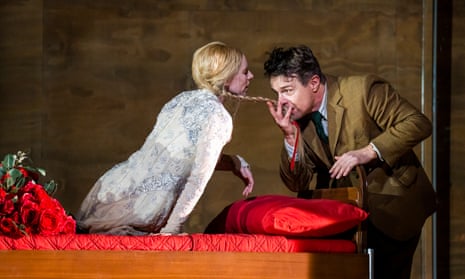The central character in Die tote Stadt (1920) keeps a plait of his dead wife’s hair in a glass jar and fantasises about a doppelganger sex goddess. Erich Korngold’s youthful work plays to our worst fears of loss and loneliness. Called The Dead City in English National Opera’s new staging, this is the second production for the company by its artistic director, Annilese Miskimmon, following success last year with The Handmaid’s Tale. Again she has made a taxing choice. Despite the overdue recognition of Korngold (1897-1957), Die tote Stadt – banned by the Nazis then neglected for decades – is still a relative rarity. The Austrian-born composer moved to the US and triumphed in the golden age of 1930s and 40s Hollywood. That popularity long scuppered his wider “serious” reputation. His fertile gift for melody shines through The Dead City.
Written in the aftermath of the first world war and based on Georges Rodenbach’s short novel Bruges-la-Morte (1892), the work is often spoken of as a study of grief. Grief, we might argue, is more nuanced, an ebb and flow. The dominant force here, annihilating, engulfing, crushing all in sight, is obsession. Two lead singers (the Swiss tenor Rolf Romei and British soprano Allison Oakes), playing lovers of a hallucinatory kind, hurtle and soar above the tidal waves of Korngold’s rich, fortissimo orchestral music. Theirs is a prolonged cry of agony, a vortex of mutual incomprehension. The pauses, when they come, as in the lovely Pierrot’s Song, are balm.
Despite the score’s voluptuous attractions, its colours as strange and saturated as the blue horse paintings of Franz Marc, the opera remains static. Mood is more important than action. The work has many devotees. I envy them. After several attempts, its rewards remain closed to me. I will persist.
Paul keeps a room as an uxorial shrine to the late Marie (her spectral double here acted by Lauren Bridle). He is attracted to Marietta, a dancer, but his affair with her is a torrid nightmare. Eventually he wakes up and moves on. Two other characters, alas hardly developed, occupy more solid ground: Brigitta the housekeeper (Sarah Connolly, inviolable in voice and presence) and Paul’s friend Frank (Audun Iversen).
If the work is problematic, the commitment of the ENO cast, chorus, orchestra and production staff is not. Miskimmon and her team – designs Miriam Buether, costumes Nicky Gillibrand, lighting James Farncombe, movement Imogen Knight – have opted for a mix of realism and reverie. The fixed set is a domestic salon with grand 1920s lighting fixtures from which Marietta twirls in satin and lace basque. Doctors, nurses, a wheelchair, hospital bed, priest, bishop, altar servers, top hats, bowler hats, umbrellas and, at the end, the ghost of Marie sitting, Etruscan style, astride a suspended sarcophagus, provide busy, at times chaotic distractions. Visual echoes of a misty, Belgian symbolist-surreal world (James Ensor, Léon Spilliaert, René Magritte) create a handsome appearance.

Romei (Paul), recovering from illness but you would scarcely know, and Oakes (Marietta/Voice of Marie) were fearless and indefatigable. Members of Finchley Children’s Music Group and the ENO chorus added well-drilled aural variety, with sharp cameos from Clare Presland and Innocent Masuku. Spilling out beyond the pit into side boxes, ENO’s orchestra played with industrious fluency under the restless, exciting baton of Kirill Karabits, best known in the UK as chief conductor of the Bournemouth Symphony Orchestra and, as he showed here, especially skilled in 20th-century repertoire.
From dead city to dark land, scorched by the horrors of the Vietnam war: Black Angels (1970), by the American composer George Crumb, who died last year aged 92, was the centrepiece of an aurally expansive concert by Manchester Collective. Sonic expansion is this group’s native habitat. Even so, the range – from a new piece inspired by a root vegetable to Schubert’s Death and the Maiden (second movement only) – was exceptional. This sixth and final date in the collective’s spring tour took place in a darkened Hall Two at Kings Place, the repertoire ideal for the London venue’s year-long Sound Unwrapped season.
Written in 13 sections for amplified string quartet, Black Angels requires players to upend their sense of themselves as performers. Crumb instructs each musician to play percussion (metal thimbles, suspended tam-tams, maracas) and to chant, tongue-click, shout and whisper in different languages. The centrepiece is the Pavana Lachrymae, in which a disembodied version of Schubert hovers, musicians instructed to perform like a spectral Elizabethan viol consort. The last section opens with the eerie, fragile chimes of water-filled crystal glasses, the entire work ending, as it began, with Night of the Electric Insects.

This stark masterpiece, half a century old, sounds new and unflinching in its contemplation of warfare. The remainder of the programme, benefiting from the hall’s state-of-the-art new sound system, charmed as well as engaged: Carrot Revolution by Gabriella Smith, a pulsating romp in which viola and cello double ingeniously as rhythm section; Edmund Finnis’s sinewy, lyrical String Quartet No 2; and Dream Culture, wistful and edgy, by the American poet-musician known as Moor Mother, a world premiere and her first chamber commission.
For 20 years, Streetwise Opera has brought together people who have experienced homelessness, helping in the rebuilding of lives through creativity and singing. In the company’s latest endeavour, the cities of London, Manchester and Nottingham unite under the heading Re:sound. Nine micro-operas, written by composers in collaboration with Streetwise members, with full orchestra and catchy, jazz ballad-inspired choruses, explore every aspect of city life, from a bus ride in London to meeting under the station clock in Nottingham to the aquatic pleasures – including rain – of Manchester.

After performances in Manchester and Nottingham, this operatic journey arrived at the Queen Elizabeth Hall. Some 70 Streetwise performers were joined by the BBC Concert Orchestra (who also swung in style in works by Leonard Bernstein, Aaron Copland and Errollyn Wallen) and singers from the Sixteen. The theatre company 1927 had created enchanting graphics. With confident voices and a spirit of optimism the cast sang their hearts out, ending in unison with the word “respect”. No wonder we all rose to our feet at the end. Respect.
Star ratings (out of five)
The Dead City ★★★★
Black Angels ★★★★
Re:sound ★★★★★
The Dead City is at the Coliseum, London, until 8 April
Re:sound: Voices of our Cities is on BBC Sounds

Comments (…)
Sign in or create your Guardian account to join the discussion